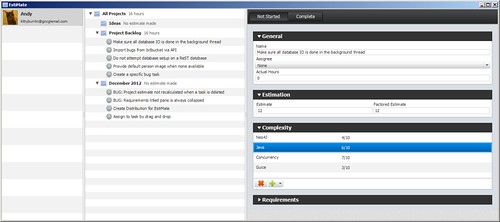- Task complexity, how complex it the task and how confident is the assignee with that technology.
- Quickly documenting what a task consists of and breaking it into smaller tasks
- Having a history of past estimates and how they worked out.
There are many many more factors which affect estimation but these are the things that I want to implement first.
So, what does it do? At the moment it has some characteristics of an ERP application. You are able to add some projects, tasks and people to implement them. Tasks can be estimated and the sum of estimates are calculated for a project.
Complexity is taken into account which I think is a huge factor in any task. Tasks can be assigned "skill requirements" such as Java, SQL or anything you think you need and then can be rated out of ten. People can assign skills to themselves and rate themselves. If a task has skill requirements greater than those possessed by the assigned person then the estimate for a task is increased. I plan to improve this calculation by allowing the estimate to be increased by a percentage set in the project, instead of by a fixed number. Other factors affecting the time that a task can take will also be added.
Tasks can also be "templated", this means that the information entered for this task can be recreated. This is great for reoccurring tasks like builds, deployments or coding tasks that are very similar. It will allow these tasks to look similar and have a consistent base for estimation but be flexible and allow changes as needed. I plan to improve this to capture best practices such as including sub-tasks for testing or bug fixing that are percentages of the task estimate or perhaps even complexity.
EstiMate uses JavaFX for the frontend GUI and neo4j for data storage. It allows the user to keep a local database, to use a shared neo4j server or a neo4j database hosted on the Heroku platform. It is pure java and shouldn't need any set-up once I create an installer. At the moment, you can download the code from bitbucket and run it from your favourite IDE or command line (there might be a Maven hack there right now so be warned!).
It is licensed under GPLv3. I have blogged about some of the code I have written for this project so assume any code in this blog is free for you to use in any way you see fit without recourse to Me if it doesn't work of course!
If you have an idea or opinion or would like to contribute that would be great, feel free to comment here or tweet me @andy_till.

